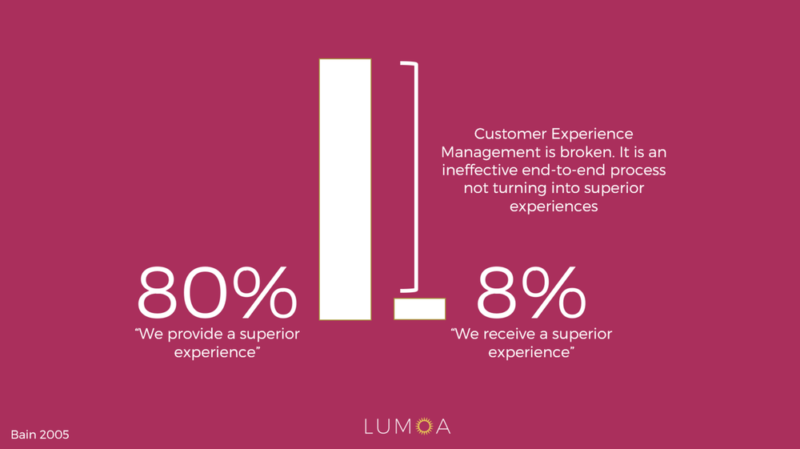What is Customer Experience According to 15 CX Experts

Last updated on February 6, 2024
When we discuss with people what Lumoa is and what we do, a very basic question gets asked surprisingly often:
What is customer experience?
Customer experience refers to how customers perceive their interactions with your company.
This definition is simple but manages to capture all the key things, and it is still as relevant now in 2019, as it was 20 years ago. Customer experience is constructed in direct or indirect interaction with your company, but it always involves the subjective response of the customer. Therefore, you can never fully determine it.
Direct contact typically takes place during the purchase, use, and service. It can include customer that visits your website, or social media channel, to do some research before making the purchase decision. It is impacted not only by the quality of your product or service but also by the expectations the customer happens to have towards them.
Indirect contact can mean word-of-mouth recommendations or criticisms your customer happens to hear, advertising, reviews, etc. Therefore, it is built as a sum of how customers engage with your brand.
As a company, you can influence, but not perfectly define what your company’s customer experience will be like. The experience involves emotion and unexpected behaviors. The perception is never exactly as you anticipate. But no company can afford to give up in the face of unpredictably.

Building a good customer experience is not easy. In an often-cited Bain & Company study, only 8% of customers said they received a superior customer experience, while 80% of the companies surveyed believed that the experience they were providing was superior.
This is a stark contrast indeed!
This is where customer experience management comes into the picture as a key way to close the gap between these two numbers.
What is Customer Experience Management?
Customer experience management (CEM or CXM) has too many definitions. For us, it means tracking and understanding your customers’ experience, acting on that understanding, and closing the loop with the customer.
To start managing your customer experience, you have to answer the question:
How do you track the customer experience?
Customer experience is partially a subjective matter. It is not fully in your control as it involves the emotions your customer has when interacting with you, either directly or indirectly. Therefore, you need to ask. You need to listen to what the customer says.
There are many ways to collect customer feedback, and several customer experience metrics to use. Net Promoter Score® (NPS) is one of the most powerful methodologies. With the two questions, the NPS method includes, you get both a quantitative metric to follow and good quality text feedback to draw insights from.
After collecting feedback, you need to also understand it.
If you have 30 customers, you can just read the feedback through and get a good idea of what your customers think. If you have 3000 customers, it will get somewhat tricky. But if you have 30,000 or 300,000 customers, you’ll need advanced tools to aggregate the feedback and analyze the text.
If you are not able to see the wood from the trees, you too easily end up listening to only those who shout the loudest. (Or only those whose opinions you happen to agree with.) Make sure you focus on the analysis phase properly. Collecting feedback and not doing anything with it, is worse than doing nothing at all.
After understanding what drives your customer experience positively and negatively, it’s key to close the loop. This means acting on the feedback, e.g. fixing the issues customers have pointed out.
It also means getting back to your customers in one way or another, to let them know that you have heard them, and have made decisions based on what they had to say.
What to Focus On in 2019
The expertise field of customer experience has been constantly developing over the years. 10 years ago, we were talking about digital transformation, rise of social media, and mobile interactions. Now Customer Experience involves modern AI technologies and hyper-personalization.
We asked 15 leaders and practitioners of Customer Experience Management what they thought Customer Experience would be in 2019.
Here are our findings.
Shep Hyken, Cx expert and bestselling author of The Convenience Revolution
“Customer Experience has moved from being focused on customer service to the entire experience a customer has with the company. That means every interaction, large or small, and that includes any and every interaction the customer has with the organization’s employees, the packaging of products, the experience navigating through a website, advertising/marketing messages via traditional and digital, interactions on social media, etc.
In the coming year(s), organizations, big and small, will recognize that CX is as important as anything else they offer their customers.
Furthermore, customers are not comparing the companies they do business with to direct competitors anymore. They make comparisons to the best service and CX they have ever received from anyone and any company.
Customers are growing increasingly smarter when it comes to CX, and that’s because rock-star companies teach them what it is, and now they expect that from everyone they do business with.
So, how is all this shaping up for 2019?
Beyond the digital customer experience, there will be a big push toward creating a more convenient customer experience. Customers expect the company will sell a good product and deliver a good service experience.
The next level is to be easy to do business with. The company that is easiest to do business with will win. Convenience will help you stand out and disrupt your competition.”
Jeanne Bliss, Cx Practitioner & Pioneer, Keynote Speaker, and Author
“Customer Experience must be about leadership. In 2019, I am working with leaders around the world to elevate the accountability and responsibility of leadership teams.
When “CX” is measured by actions to “fix” problems (a good start), but not paired with a change in the company’s behavior for how they go to market, enable employees to thrive and honor customers – then it is not sustainable.
The work ends when the project ends, or the person pushing it moves on, or leaders find another priority. This is much of what we are seeing as CX is dipping inside organizations.
Without uniting the C-Suite and making elevating behavior, modeling behavior, and permitting people to act differently…companies will not fundamentally change.”
Ian Golding, CCXP, CX Consultant and Trainer
“Customer Experience is very simply explained as everything an organization does to deliver the ‘end to end experience’ to a customer. From advertising; to PR and media; to sponsorship; to websites and apps; to physical interactions (stores and branches); to products; to documentation; to employee behavior; to communication; to Customer Service, etc…
In 2019, the ‘noise’ surrounding CX will continue to increase as more and more industries facing disruption seek to differentiate themselves ‘beyond their products and services’.
However, the CX profession will have to continue working hard to ensure that evolving digital technologies are used to enhance the customer experience and thus make the delivery of experiences more cost-effective, rather than seeing technology as a way to replace human beings and save money!”
Maurice FitzGerald, keynote speaker, and author
“At a macro level, customer experience is the overall impression or image your brand creates in the minds of your customers. That impression is of course far greater than any individual experience.
Of course, your overall brand image exists primarily at an emotional (rather than rational) level. Once established at that emotional level, rational thoughts, and actions have only a small effect at any given time.
Technology development means that 2019 should be a breakthrough year in two areas, one obvious, the other less so: The obvious one is that advancements in Natural Language Processing will finally allow correct automatic interpretation of customers’ written and spoken feedback. The two biggest current gaps are the correct interpretation of pronouns and context.
The less obvious breakthrough is in the automation of loop-closing. If we can correctly interpret what a customer is writing, why could we not simultaneously tell them what we are already doing to work on the suggestion they are making, or automatically pop up a solution to a problem they are describing.
This will at least partly address the big issue of customers providing feedback and never hearing anything back.”
Jeremy Watkin, Director of Customer Experience at FCR
“At the core of customer experience work is the ongoing process of making the experience better for our customers. It’s awfully difficult to do that without first gathering feedback both from our customers and the people serving our customers.
This gathering process not only helps discover a rating or metric (like Customer Satisfaction, Net Promoter Score, or Customer Effort Score) but it also uncovers the drivers that negatively impact the experience.
Once these are known, the real work begins of aligning people, process, product, and policies in such a way that measurable improvement occurs. And this IS hard work!
Looking ahead to 2019, it’s exciting to see the continued improvement of the technology required to gather feedback and monitor real improvement. As this happens, CX work becomes all the more accessible to folks in a variety of roles within organizations.
Isn’t that the point of CX — to break down silos and get everyone working together to bring about continuous improvements? I think so.”
Sue Duris, Customer Experience, and Digital Marketing Consultant
“My favorite definition of CX is also from Forrester that goes “Customer experience refers to how customers perceive their interactions with your company”. It not only includes the what’s (interactions) but also the how’s (perceptions, feelings) of the customer experiences.
For CX to even exist you have to be customer-centric. It just doesn’t work otherwise. It surprises me how many product-centric businesses are out there that even with some small mind-set shifts can easily migrate to customer-centricity.
I see a few trends happening in 2019:
-
-
Companies finally getting the message that employee engagement drives CX. We’re going to see much more EX and CX alignment,
-
Much more alignment between Customer Success and Customer Experience. Each can help the other to optimize the CX,
-
Emerging tech is going to help bring more maturity to CX programs. Emerging tech is going to continue to augment CX, not replace it, and it will become more of a gap filler so brands can go deeper with customer understanding so they can go deeper with personalization. Some of the emerging tech that is going to drive this include AI, IoT, blockchain, and immersive (VR, AR, mixed reality). “
-
Peter Gustavsson, CX Strategy Consultant
“Just a few years and a short breath ago, CXM rocketed off together with digital transformation and was expected to interrupt businesses as a terminator from the future, but today it has left “digital” behind and transformed itself into a blur of good intentions.
From to, the commercial perspective, it’s clear that CXM cannot only include technology nor how to operate these new gadgets. It’s obviously crucial not only to embrace organizational structure, managerial routines, and systems, as how offers are planned and bundled, how content is developed and presented, and how effects are targeted, measured and appreciated. It’s equally important to align top management executive teams in traditional line organizations, to coordinate cross-functional processes, be prepared to challenge corporate culture and traditional ways of working, to take on a customer focus, and by no means forget that eventually speed in flexibility is vital.
Technology is still at CXM heart during 2019. It’ll help to achieve capabilities for omnichannel personalization, marketing automatization over all touchpoints, and lifelong individual customer experience management, also in legacy environments.”
Lyndon File, Director of CX & Advocacy, G Adventures
“I believe 2019 will see many developments in the field of Customer Experience. First, I am convinced that there will be a swing toward making all interactions more human. I am all for having robots help us identify trends and provide basic information. But having a real live human provide a personalized interaction will be a thing in 2019.
Also, tied in with this is the idea that customers expect instant gratification. They want to know the answer to their query now. Not this week, not tomorrow, not even later today. NOW.
Companies that have the scalability to provide a personalized instant engagement will be winning the CX game in 2019.”
Nate Brown, CX Director, Co-founder at CX Accelerator
“Customer Experience means a great deal to me. It’s really all about being intentional to make people’s lives better and easier…which is a cause I can get behind. Brands that refuse to put in the time, energy, and resources to create great Customer Experiences are demonstrating a great deal of selfishness. Some companies can float by on a level of innovation for a period of time, but the lasting brands are those who consistently value their customers.
I believe in 2019 we will see the Customer Experience function garner a significantly wider span of control. Historically, many Customer Experience professionals have little to no ownership over the critical factors that make up the Customer Journey. Examples of this would include Employee Experience, Product Innovation, and Marketing.
When Customer Experience is reduced to simply Voice of Customer and/or Customer Service, it’s nearly impossible to take a holistic approach. When CX has control of or at least significantly greater influence in these areas, we can truly make a difference for the people we serve.”
Martina Koch Olsen, Customer Success Specialist, Pleo.io
“One thing I do hope more companies will focus on improving in 2019 is their omnichannel support system(s). In my experience, there’s been a high focus in the past few years on companies’ presence across channels, yet many don’t have a system where information can easily be passed on from one channel to another (and from one team to another). Sometimes they work completely in silos.
To me, great customer service is not just about resolving issues fast. It’s very much also about the experience of the service itself. A great omnichannel system can help you move your customer’s experience from okay to great!”
Kari Korkiakoski, CX Consultant and Founder, Futurelab Finland
“I think customers’ expectations are getting higher and we even see drops in survey results. This is not a project, CX should be the purpose of your company.
The year 2019 is about emotions. Focus on that! Define targeted emotions through customer journey.”
Adam Toporek, CX Consultant, Author, & Speaker
@adamtoporek | blog
“To me, customer experience is more than a business discipline, it is a way of life for customer-centric organizations. Customer experience represents the most powerful lens for looking at the totality of a customer’s interactions with an organization and trying to maximize not only the value of each individual interaction but the customer’s overall journey.
In 2019, I expect to see both big advancements and significant headwinds for customer experience as a focus in organizations. The experience will be increasingly more integrated with improving technology like AI, and this will dovetail with budget pressure and the demand for demonstrable ROI from leaders. CX leaders will have more pressure to prove the financial results of experience and to produce those results at lower cost.”
Kaye Chapman, Comm100‘s Learning & Development Manager and Community Organiser at CX Accelerator
“I’m definitely seeing CX leaders looking to adapt faster to changing customer preferences and getting their operations ready to adopt automation and bot technologies. From building stronger knowledge bases to aid human and bot knowledge to providing great service over new channels, the CX industry is becoming ever more strategic and aligned to customer needs.
I’m sure in 2019 we’re going to see a lot of messy implementations of new technology and processes, but I hope that amidst the rubble of CX disasters we’ll see organizations getting really innovative and providing service in ways that just weren’t possible a year ago.
I’m especially excited to see more and more organizations adopting chatbots that provide quick, quality answers in appropriate places in the customer journey and which show that bots, when properly designed and trained, can be a real asset to customer service operations.”
Linda Ruffenach, EVP of Operations at GlowTouch Technologies
“The customer experience conveys the true essence of a company’s brand. It may be the only live in-person experience an individual has with a company. No matter how good the marketing and sales, it can all be lost if the actual interactions with the brand do not align.
Customers are looking for convenience, quality, and confidence that their issues are being resolved and their information is secure. In 2019, I expect to see the continued focus on the end-to-end customer experience.
Companies will continue to provide options for customers that allow a resolution to customer inquiries through multiple channels, including AI and self-service. Innovation in AI and self-service can be a real game-changer, but it is critical that the personal connections with a company’s brand are not diluted along the way.
Customers with a positive personal connection to your brand will remain loyal, buy more stuff, and become advocates for your brand.”
Vincentas Karciauskas, Customer Success at Airtame
“Customer experience for me is everything the customer feels about the company. So not only the experience with product or design but also experience with communication, replacements, marketing.
Customers should feel comfortable to communicate, enjoy to use the products, not be afraid or limited to ask questions, and find answers. All this creates a unique customer experience and keeps customers loyal to the company.
I think in 2019, the CX industry will need to find new ways to innovate. A lot of things that industry is doing now is a bit older or getting there, therefore innovations and ways to improve it will be key.”
Gustavo Imhof, CX Keynote Speaker and CX Manager at Lowell
“Customer Experience has had many, many definitions over the years. Most of them are either impracticable (theory of everything type stuff) or bordering on naive (it’s being nice to the customer).
My stance is that customer experience as a profession, as a strategy, is about the measurement, monitoring, and management of memorable experiences customers have. I make this distinction on them remembering things because only something the customer can remember will actually influence their future behaviors – and therefore business success. Working on anything else is a waste of energy, time, and resources, plain and simple.
A successful customer experience strategy harnesses the understanding of what the customer remembers and how to design memorable experiences to spark rapid and sustainable growth.
I feel 2019 is some sort of a crossroads year. Some businesses will be faced with the decision on whether they are ready to truly embrace customer experience as a strategy and face the challenges of legacy systems and cultural transformation. The businesses who are more advanced with their transformation will come to terms with the fact that ‘digital transformation’ is just one facet of a successful customer experience strategy, and will finally embrace a more holistic view of the customer experience.
That’s what 2019 will be about, true business transformation through people, not AI, AR, VR, or any other acronym or technology.”

